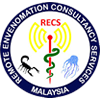Naja siamensis
Taxonomy
-
Kingdom
-
Phylum
-
Class
-
Order
-
Family
-
Genus
-
Specific Epithetsiamensis Laurenti, 1768
-
Common Name
- Black And White Spitting Cobra (English)
- Indo-chinese Spitting Cobra (English)
- Indochinese Cobra (English)
- Indochinese Spitting Cobra (English)
- Siamese Cobra (English)
- Siamese Spitting Cobra (English)
- Ular Senduk Indochina (Malay)
-
ResidentialNon-Native
Description
Naja siamensis or the Indochinese spitting cobra has an average size of 120 – 160 cm. When it is being threatened, it can raise its anterior third, expand the hood, give warning sounds and spit its venom. However, the hood marking is absent or present either in U, V or H-shaped. The snake body coloration is variable which can be dominant white, white and black, uniform black or uniform brown (Sibunruang et al., 2013).
Habits
| No | Part | Habit | |
|---|---|---|---|
| 1 |

|
Oviparous — Reproduction through production of eggs that have membranes and/or shells.
|
|
| 2 |

|
Venomous — Capable of injecting venom by means of a bite or sting.
|
Assessment
| Year Published | Assessment | Red List Category | Version |
|---|---|---|---|
| 2012 | IUCN Red List of Threatened Species |
Vulnerable (VU)
|
3.1 |
| 2010 | IUCN Red List of Threatened Species |
Least Concern (LC)
|
N/A |
Emergency Contact
Biodiversity Experts
| Profile | |
|---|---|
|
Amirrudin Bin Ahmad (Dr.)
Universiti Malaysia Terengganu (UMT)
|
Amphibians, Dragonflies and Damselflies, Fishes, Reptiles,
Biodiversity, Data Analysis, Digital Sequence Information (DSI), Living Modified Organism (LMO), Marine & Coastal, Protected Areas & Invasive Alien Species
|
|
Chen Pelf Nyok (Dr.)
Turtle Conservation Society of Malaysia (TCS)
|
Turtle, Tortoise, and Terrapin (Ecology), Reptiles (Ecology),
Biodiversity, Conservation, Education & Environment
|
|
Kaviarasu Munian (Mr.)
Forest Research Institute Malaysia (FRIM)
|
Reptiles (Ecology), Amphibians (Ecology), Fishes (Ecology),
|
|
Lim Boo Liat (Dr.)
|
Reptiles (Ecology), Rodents (Ecology), Amphibians (Ecology),
Biodiversity, Ecosystems & Invasive Alien Species
|
|
Mohammad Shahfiz Azman (Mr.)
Forest Research Institute Malaysia (FRIM)
|
Amphibians, Mammals, Birds, Amphibians, Reptiles,
Awareness, Biodiversity, Conservation, Ecosystems, Environment, Forest, Landscape, Law and Policy, Management, Protected Areas, Science, Systematics, Invasive Alien Species, Like-Minded Megadiverse Countries (LMMC), National Policy on Biological Diversity, Policy, Research and Development (R&D) & Zoonotic
|
|
Mohd Abdul Muin Bin Md Akil (Mr.)
Universiti Sains Malaysia (USM)
|
Amphibians, Birds, Reptiles, Snakes,
Biodiversity, Conservation, Evolution, Genetics, Molecular, Protected Areas, Climate Change & Invasive Alien Species
|
|
Mohd Uzair Rusli (Assoc. Prof. Dr.)
|
Turtle, Tortoise, and Terrapin, Reptiles,
Conservation, Data Analysis, Ecology & Marine & Coastal
|
|
Mohd Zulfadli Bin Mohd Arshad (Mr.)
Department of Wildlife and National Parks (PERHILITAN)
|
Rodents (Taxonomy), Reptiles,
Molecular, Biodiversity & Science
|
|
Norhayati Binti Ahmad (Prof. Dr.)
Universiti Kebangsaan Malaysia (UKM)
|
Frogs and Toads, Snakes, Amphibians, Reptiles,
|
|
Teo Eng Wah (Dr.)
University of Malaya (UM)
|
Reptiles, Amphibians,
Invasive Alien Species
|
References
- Guidelines for the Management of Snakebites, 2nd edition, 2016. WHO Regional Office for South-East Asia, New Delhi, India. pp. 206.
- Snake Farm Exhibition, 2010. Snake Farm, Queen Saovabha Memorial Institute, The Thai Red Cross Society, Thailand. pp. 97.
- Das, I. (2012). A Naturalist's Guide to the Snakes of South-east Asia : Including Malaysia, Singapore, Thailand, Myanmar, Borneo, Sumatra, Java and Bali. John Beaufoy Publishing, Oxford, England. pp. 70-71; 160 pg.
- Sibunruang, S., Suteparuk, S. & Sitprija, V. (2013). Manual of Practical Management of Snake-bites and Animal Toxin Injury. Bangkok: Queen Saovabha Memorial Institute, The Thai Red Cross Society, Thailand. pp. 88.
- Sitprija, V. & Suteparuk, S. (2012). Clinical Physiology of Animal Toxins: An Overview. Queen Saovabha Memorial Institute, The Thai Red Cross Society, Thailand. pp. 119.
- Akta Pemuliharaan Hidupan Liar 2010 (2010) — [ Adobe PDF (PDF) ]
- Akta Perdagangan Antarabangsa Mengenai Species Terancam 2008 (2008) — [ Adobe PDF (PDF) ]
- International Trade in Endangered Species Act 2008 (2008) — [ Adobe PDF (PDF) ]
- Wildlife Conservation Act (2010). Laws of Malaysia Act 716 — [ Adobe PDF (PDF) ]
Publications
Acknowledgements :- Ms. Aida Salihah Binti Abu Bakar, Ms. Ajla Rafidah Baharom, Mrs. Nur Hazwanie Binti Abd Halim, Mrs. Nurfarhana Hizan Binti Hijas, Ms. Nurul Aimi Amirah Binti Mohd Zaki, Mr. Tan Kok Kiat & Mr. Yasser Mohamed Arifin
Species Citation :- Naja siamensis. Malaysia Biodiversity Information System (MyBIS). Accessed via https://www.mybis.gov.my/sp/48931. [Retrieved 03 May 2024].
Feedback :- If you see any errors or have any questions or suggestions on what is shown on this page, please provide us with feedback.

